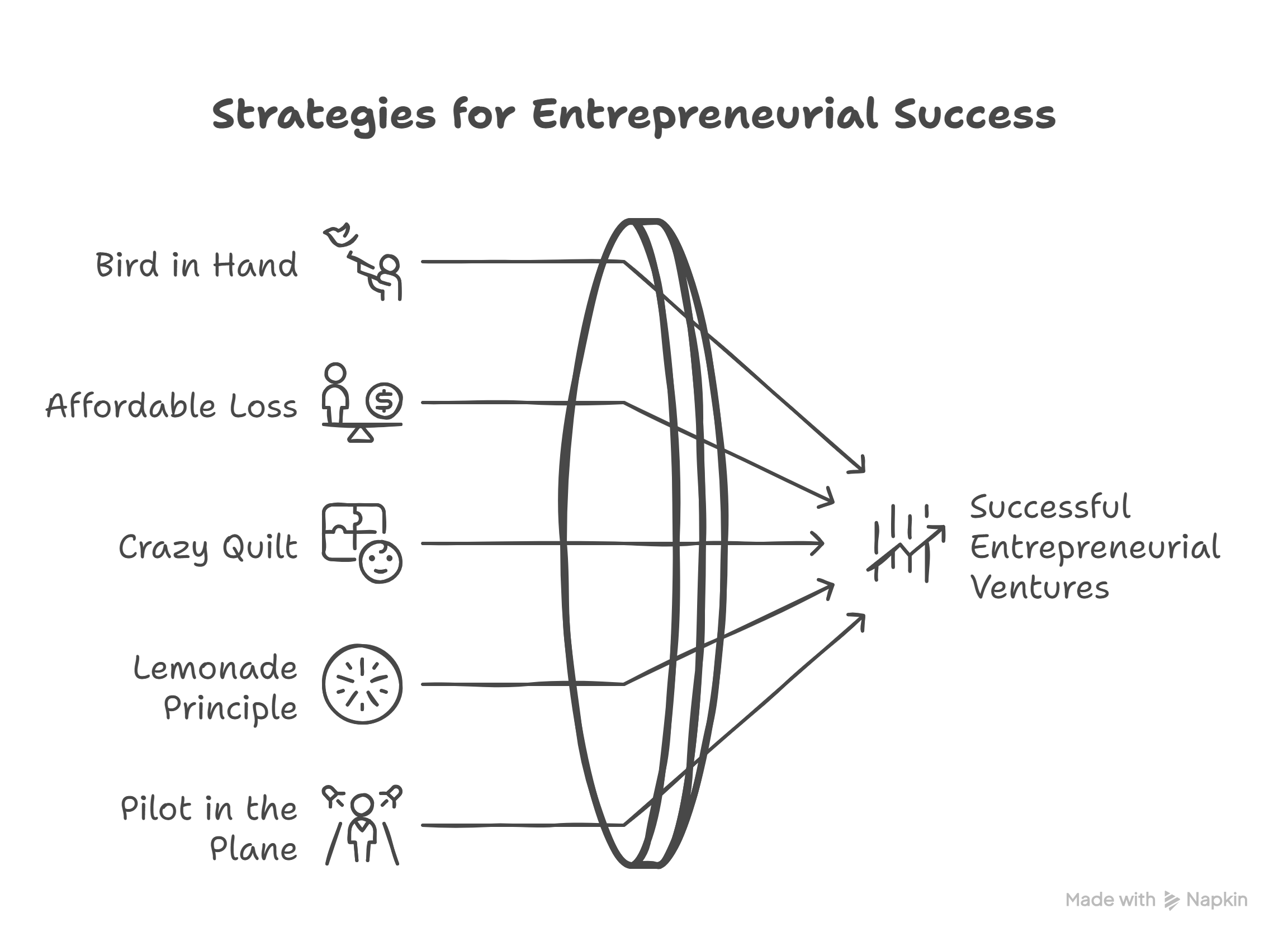Principles of Effectuation
Effectuation is a decision-making framework used by entrepreneurs to navigate uncertainty. Unlike traditional causal logic (goal-first planning), effectuation starts with available resources and adapts through experimentation, partnerships, and leveraging surprises.
Core Principles of Effectuation
1. Bird in Hand (Means-Driven)
- Definition: Start with what you control—your skills, network, resources.
-
Examples:
- Gyanesh Pandey (Bihar microgrids): Used his electrical engineering skills for rural electrification.
- Taga Rita (Nara-abba): Applied agri-engineering expertise to reduce fruit wastage in Northeast India.
-
Application Questions:
- Who am I?
- What do I know?
- Whom do I know?
2. Affordable Loss
- Definition: Focus on controllable risks, not just expected returns.
-
Examples:
- Chumbak Founders: Sold their apartment (₹50 lakhs) but could return to IT jobs if needed.
- Zhang Yin (Nine Dragons Paper): Explored U.S. cardboard waste with only minimal savings.
-
Application Question:
- What am I willing to lose?
3. Crazy Quilt (Co-Creation)
- Definition: Build partnerships to co-create the future.
-
Examples:
- Greg Gianforte (SaaS pioneer): Collaborated with customers to design CRM software.
- E-curtains: Partnered with fabric suppliers and research institutions.
-
Application:
- Invite stakeholders early (customers, suppliers, even competitors).
4. Lemonade Principle
- Definition: Turn surprises into opportunities.
-
Example:
- Bare Necessities (Sahar Mansoor): Pivoted to sustainability workshops during COVID as eco-awareness surged.
-
Application:
- Treat disruptions as data points to pivot or innovate.
5. Pilot in the Plane (Control vs. Prediction)
- Definition: Focus on actions you control, not predicting outcomes.
-
Example:
- Flipkart: Introduced cash-on-delivery despite no credit-card culture.
-
Application:
- Iterate based on feedback rather than rigid plans.

Risk vs. Uncertainty: The Jar Experiment
| Jar | Contents | Implication |
|---|---|---|
| Jar 1 | Predictable (Snickers, Ferrero Rocher) | Use historical data (e.g., fest budgets). |
| Jar 2 | Unpredictable (lemon, ping-pong ball) | Requires iterative learning (e.g., prototype tests). |
Causal vs. Effectual Mindset
| Aspect | Causal Logic | Effectual Logic |
|---|---|---|
| Starting Point | Fixed goal (e.g., “I’ll build e-curtains”) | Available means (e.g., “I know e-textiles”) |
| Risk Approach | Maximize returns with risk-adjusted plans | Focus on affordable loss |
| Partnerships | Transactional (hard bargains) | Collaborative (co-creation) |
| Surprises | Avoided as disruptions | Leveraged (e.g., pandemic pivots) |
| Outcome | Predictable (e.g., annual fest) | Emergent (e.g., pivoting to new products) |
Application in Venture Types
-- Revolutionary Ventures (Zero-to-One):
- Example: E-curtains (electronic textiles)
- Challenge: High uncertainty, resource-heavy.
-- Propagatory Ventures:
- Example: Flipkart (Amazon model + cash-on-delivery)
- Focus: Adapt existing models to new contexts.
-- Lifestyle Ventures:
- Example: Design studios (founder’s expertise)
- Focus: Low-risk, skill-driven.
Key Takeaways
- Use Effectuation Early: When uncertainty is high (e.g., validating e-textiles).
- Switch to Causal Later: For scaling (e.g., revenue targets post-validation).
- Embrace Surprises: Pivot like Sahar Mansoor during COVID.
- Partnerships Matter: Co-create with stakeholders (e.g., Greg Gianforte).
Examples Recap
- Chumbak: Embraced affordable loss.
- Bare Necessities: Turned COVID into a sustainability opportunity.
- Gyanesh Pandey: Used skills to solve rural electrification.


No Comments